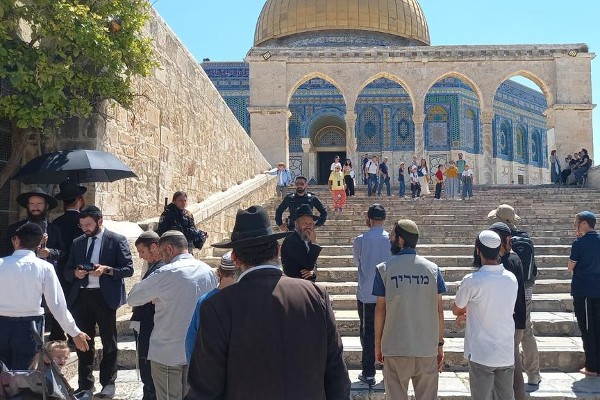Instead of providing a balanced and nuanced piece of journalism, this New York Times report is full of misleading statements and claims that reek of an anti-Israel bias.
By Chaim Lax, HonestReporting
In anticipation of the concurrence of the upcoming Jewish holiday of Passover and the Islamic holy month of Ramadan, as escalating tensions could possibly spill over into further violence, The New York Times’ Palestinian affairs correspondent, Raja Abdulrahim, recently published a piece on the fears of the Muslim artisans who renovate the Muslim shrines on the Temple Mount.
However, instead of providing a balanced and nuanced piece of journalism, Abdulrahim’s report, par for the course when it comes to her reporting on the Jewish state, is full of misleading statements and claims that reek of an anti-Israel bias.
Following are some of the more egregious examples:
Diminishing Jewish Connection to the Temple Mount
She writes “Jews believe that the [Temple Mount] compound is the location of two ancient temples,” implying that the existence of the First & Second Temples is more a matter of faith than historical fact.
In actuality, a number of ancient remnants discovered by archaeologists in the area by the Temple Mount (the Mount, itself, has never been excavated) point conclusively to the existence of both Temples.
In addition, aside from the archaeological evidence, the existence of the Temple at this site was even confirmed in the early 20th century by none other than the Supreme Muslim Council, which stated in a 1925 pamphlet that “[The Mount’s] identity with the site of Solomon’s Temple is beyond dispute.”
No, @nytimes, those two ancient temples are not merely a “belief.” They are an accepted historical fact with archaeological evidence to back it up.@RajaAbdulrahim, stop diminishing the indisputable Jewish physical connection to the Temple Mount. https://t.co/gFuMVrLTRa pic.twitter.com/47ZWo7C6x1
— HonestReporting (@HonestReporting) March 23, 2023
Erasing the Context
Raja Abdulrahim seeks to contextualize her piece by writing:
The atmosphere is already tense amid an escalation of violence in the Israeli-occupied West Bank. It has been the deadliest start of a year for Palestinians in the territory in more than two decades as settler violence increases and as Israel steps up lethal raids in response to a series of attacks by Palestinian armed groups.
This is, however, far from accurate context.
Abdulrahim seemingly seeks to place the blame for the latest wave of violence entirely on the backs of Israelis by failing to mention that the majority of those Palestinians killed are aligned with Palestinian terror groups, that the “attacks by Palestinian armed groups” were lethal and led to one of the bloodiest years for Israelis in recent decades, and that the entire wave of violence began with a string of Palestinian terror attacks, not Israeli actions.
THREAD: 2023 has seen increased terror attacks & IDF counter-terror operations, with an equal number of Israeli & Palestinian civilian casualties.
Yet the media reports all Palestinian deaths equally, choosing not to mention that 49/60 deaths were confirmed terrorists. pic.twitter.com/4dBvqg9QoH
— HonestReporting (@HonestReporting) March 1, 2023
Historical Revisionism
One further example of Abdulrahim’s inaccurate reporting is her claim that Ariel Sharon’s 2000 visit to the Temple Mount “set off the second intifada, or Palestinian uprising.”
As HonestReporting has previously explained, Palestinian, Israeli and American officials have all gone on record to state that Sharon’s visit was an excuse exploited by the Palestinian leadership, which was already planning anti-Israel violence and terrorism.
Thus, to blame Ariel Sharon for the instigation of the Second Intifada is not only historical revisionism but also dangerous exculpation for those Palestinians who took part in one of the most violent periods in Israeli history.
Reporter’s History of Inaccurate Reporting
It is unsurprising that Raja Abdulrahim’s latest New York Times report is replete with anti-Israeli bias and misinformation. As HonestReporting and other organizations have highlighted, Abdulrahim has a long history of using her position as a journalist to spread falsehoods about Israel and to smear the Jewish state.
The following are some of the most notable examples of anti-Israel bias within Raja Abdulrahim’s reporting:
– In late 2022, Abdulrahim used her column in the New York Times to whitewash Palestinian terrorism, claiming that the majority of Palestinians killed by Israel (including those claimed as members by Palestinian terror groups) were innocent civilians. HonestReporting’s analysis proved that Abdulrahim’s claim was misleading and intended to sully Israel’s reputation.
– The New York Times was forced to issue a clarification in November 2022 after the media watchdog organization CAMERA disproved Abdulrahim’s claim that Israel and Egypt’s blockade of Gaza had crippled the Gazan fishing industry. In fact, Palestinian statistics show a marked increase in Gaza’s fishing sector over the blockade’s duration.
– In a July 2022 report, Abdulrahim falsely claimed that Israel “is attempting to criminalize certain aspects of the collective Palestinian identity” and that the Palestinian flag is “practically absent” from the streets of Jerusalem. As well, she ignored Palestinian violence while sanctioning Israel for its response.
– In June 2022, Abdulrahim wrote a one-sided report on convicted Hamas member Mohammad al-Halabi, which took claims made by his supporters at face value while seemingly discounting any evidence put forward by the prosecution.
– While a Florida University student, during the height of the Second Intifada, Raja Abdulrahim wrote an op-ed that blamed Israel for the scourge of Palestinian suicide bombing and terrorism.
Raja Abdulrahim’s latest screed for The New York Times is therefore not unique in its portrayal of the Jewish state but rather another installment in her journalistic career of anti-Israel bias, falsehoods, and misinformation.
